Water well drilling technology and its varieties
If you are going to equip your country house with an autonomous water supply and get a well, then you need to be familiar with the drilling technology. This will save a lot of time when searching for drillers and tools while drilling itself.
Therefore, we will further consider the existing technologies for drilling water wells and learn about their features.

Types of drilling technology
When building a water supply system in a private house, as a rule, one of the three drilling technologies is used:
- Rotary;
- Screw;
- Shock cable.
The difference between these technologies lies in the methods of rock destruction inside the well, as well as in methods for extracting soil to the surface. Naturally, depending on the technology, depends on the set of necessary equipment..
Why does the customer need to know these technologies? This will give an understanding of how the well will be drilled, what kind of equipment will be used for this, and how long it will take. In addition, the type of technology depends on the price of work, as well as the quality of the final result.
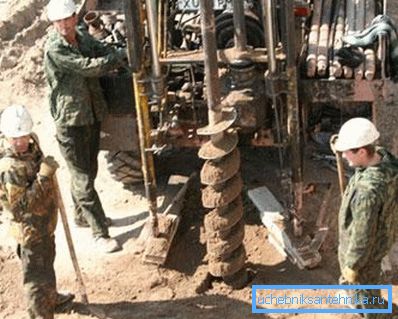
Screw method
The cheapest and easiest option is auger drilling. Therefore, most of the small-sized drilling rigs are based on this technology. It is based on the usual Archimedes screw (auger), which is used to extract the soil to the surface.
To make it easier to imagine this method, you should remember how the fishermen drill a hole in the ice. In this way you can drill wells with a depth not exceeding 10 meters.
A feature of this method is the ability to perform holes only in relatively dry and soft soils. If at the depth there are hard rocks or quicksies, then it is impossible to carry out further work using the auger method.

I must say that the technology of drilling wells under the water auger is usually used by private "drillers" who have small-sized installations. As a rule, it is easy to find organizations that provide such services.
Note! To perform a well, it is not enough to simply drill a hole in the ground. It is also necessary to protect the aquifer well from overhead, as required by the instructions. Therefore, despite the fact that the process itself is not anything complicated, the qualifications of the performers are very important.
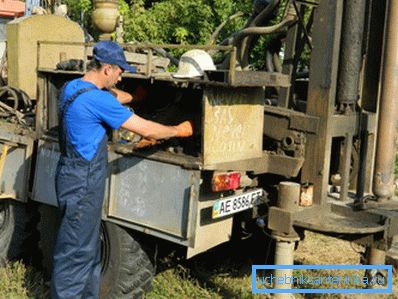
Rotary mode
The technology of drilling a well under water in a rotary way is by far the most common. To perform the hole in the ground in this way a drill pipe is used, inside of which there is a rotating shaft with a chisel at the end.
The load on the tip transmits hydraulic installation. This method is attractive because it allows drilling to virtually any depth, regardless of the type of rock.
The soil is washed out by constantly washing the well with a drilling fluid.
The solution can be fed in two ways:
- Pump into the drill pipe, in this case, the soil with the solution goes by gravity into the annulus.
- By gravity into the annulus, while the solution with the rock is forced out of the drill pipe.
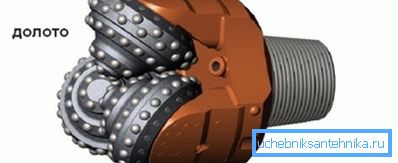
It must be said that the second method, which is called backwashing, more qualitatively opens the aquifer, so that the well will have a greater debit. However, this method is more laborious and requires more complex equipment, respectively, and is much more expensive.
Therefore, the choice of technology depends, in this case, on your budget and the required amount of water. As a rule, if it is necessary to provide one household with water, then direct-flush drilling is sufficient.
Now consider this technology in stages:
- First of all, a large diameter chisel is buried in the ground.
- Then the bit rotates from the impact of the rotor, which is driven by the engine.
- Weighted pipes are placed between the drill pipes and the bit, which give additional load.
- In the process, the soil is removed by the pressure of the fluid from the mud pump.
- Having completed the drilling of the first soil plot, a casing tube is inserted into the barrel so that the upper layers of the soil are not sprinkled into the well.
- For sustainability, the space between the soil and the first casing is filled with a solution.
- Then drilling continues with smaller bits, after which a narrow casing is submerged.
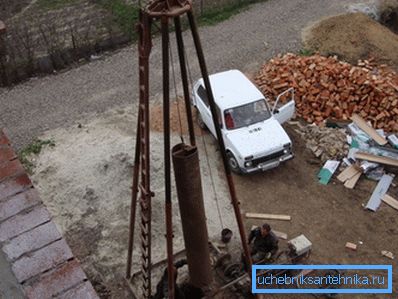
Shock rope method
This water well drilling technology is the oldest, slowest and most laborious. However, the quality of such work is the highest. Its essence lies in the fact that the rock is destroyed by crushing a powerful heavy projectile, which initially rises to a certain height, and then sharply lowers.
As a result, the projectile destroys the ground with its weight, which is multiplied by the free-fall coefficient. The destroyed breed is taken out from a trunk by means of a zhelonka. If the ground is soft, then, as a rule, the scrape and chisel are combined into one shell.
The main advantage of such drilling is that it does not require the use of a drilling fluid or water. Due to this, it is possible to open the aquifer more accurately and thereby ensure the longest service life of the well and the maximum possible debit. As a rule, wells made in this way serve more than 50 years.
The main disadvantage of this technology, for the customer, is the high cost of services. In addition to the fact that this method is labor-intensive in its own right, in the process of work it is necessary to isolate all the upstream aquifers. In other words, the number of aquifers and shafts in the well, so many casing pipes are necessary, and these are additional costs for material and the work of specialists.
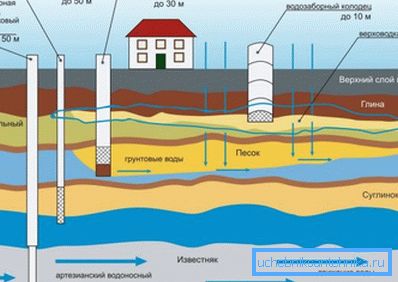
What technology to give preference
In fact, the customer doesn’t have much choice, especially if the conditions at the site do not allow to use the auger. Shock-contact method is almost completely ousted from the market by rotary drilling, which, most likely, will have to be used.
However, it is necessary to inquire about technology at least in order to determine the adequacy of the cost of services. If the soil conditions are suitable and the aquifer is not located deeply, then it is much more profitable to use the auger method.

Is it possible to complete the well by yourself
It is quite possible to break a well with your own hands, the only question is how much time and effort it takes and how well it will be possible to isolate the trunk from the upper aquifers.
Often, developers underestimate the complexity of work, as a result of which either “water from a puddle” obtained from a great depth is obtained, or specialists finish the work. At the same time, drillers have to pay almost the full cost, as if the work they performed from scratch.
Therefore, before making a decision on the independent performance of work, it is necessary:
- Explore the drilling technology in detail;
- Understand what need equipment and supplies;
- Make sure that you can drill a well on your site using a small-sized drilling rig.
Compact installations are of two types:
- Screw type - as a rule, these installations are homemade.
- Shock-cable type - installation may have an electric motor or internal combustion power unit. This is important if there is no electricity on the plot.
Tip! A drill rig is considered to be less demanding to the ground and more simple. With its help you can drill a well in almost any soil.
Conclusion
All existing technologies for drilling wells are fundamentally different from each other, however, if the work is done by professionals, then each of them allows you to achieve the desired result. In this case, one or another technology should be preferred in accordance with its own financial capabilities, soil conditions and the depth of the aquifer.
Additional information on this topic can be obtained from the video in this article.